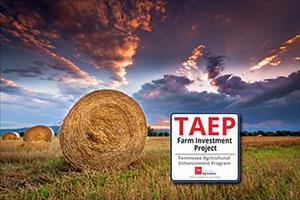 |
|
|
 |
 |
|
|
| |
|
Continuing to improve
TDA announces two new program options and other changes to TAEP
| Story by: Sarah Geyer |
8/26/2019 |

The Tennessee Department of Agriculture recently announced notable changes to the 2019-2020 Tennessee Agricultural Enhancement Program, including two
new program areas: hay equipment and herd health.
|
|
|
|
1
of
1
|
|
|
view all thumbnails for this gallery |
The Tennessee Department of Agriculture (TDA) recently announced new options and notable changes in the Tennessee Agricultural Enhancement Program (TAEP).
Tennessee’s Agriculture Commissioner Charlie Hatcher, D.V.M. says changes for the 2019-2020 program cycle will better assist the state’s farmers in diversifying, expanding, and improving their farming operations through long-term investments.
Since its launch in 2005, the annual cost-share fund administered through the TDA has invested more than $168 million in more than 57,000 producer projects, affecting all 95 counties in Tennessee. According to TDA, each dollar awarded through TAEP to an eligible farmer generates an estimated $3.89 in local economies.
“It’s a priority of the governor to help the state’s rural communities, and TAEP is an important part of that,” Hatcher says. “With that in mind, I wanted to take a closer look at the Ag Enhancement Program to see if there were opportunities for improvement, and we’ve gone through a deliberate process to gain as much feedback as we possibly could from all participants and ag industry partners.”
That process, he explains, included a survey of TAEP participants and industry partners. More than 2,400 people responded, providing feedback about current program offerings and ideas for the future. The state’s ag department also formed an advisory committee of 20 farmers from a variety of agricultural sectors statewide to identify areas for improvements.
“Based on that feedback [from the survey and the advisory board] and keeping in mind the governor’s priorities, we have made some changes that we think are for the best to further advance farming operations across the state,” says Hatcher. “Taking into consideration our limited funding, we are not offering the hay storage program for this program cycle to make room for two new program areas.”
The two new program areas are:
• A new cattle herd health program to help farmers implement a preventative herd health protocol for beef and dairy cattle. Applicants must have a minimum of 30 cattle, and the maximum reimbursement for this program is $2,000.
“Earlier this year, we ran a pilot program which was very successful,” says Hatcher. “We feel this program can help improve the health, reputation, and profitability of Tennessee cattle.”
• Hay equipment with a focus on hay production. New hay mowers, mower-conditioners, tedders, rakes, and balers are now eligible for cost share. Participants must meet minimum (operation size) requirements of 100 head of cattle, 150 head of goats or sheep, or 100 acres of hay in production. The hay equipment portion of the program will have a deadline of April 1, 2020, the same as livestock equipment. Maximum reimbursement on the new hay program is $5,000.
“We expect to have tremendous interest in both of these new programs,” says Hatcher, stressing that the hay storage program will not be offered for this cycle but hasn’t been abandoned. “We are always evaluating TAEP to respond to growing demand. We also want to ensure funding is allocated to have the most impact, and to advocate for funding increases when appropriate.”
Changes to existing programs include:
Working Facility Structures program —
• Formerly called the Livestock Working Facility Cover program.
• Features the Working Facility Cover for existing livestock working equipment and the Permanent Working Pen for receiving, separating, weaning, or holding livestock.
Row Crop Solutions program —
• Formerly called the Grain Storage program.
• Cotton has been added as an eligible commodity.
• New items include drive-over scales, stationary fuel tanks, GPS displays and receivers, grain bin rescue tubes, and no-till drills.
• The maximum reimbursement has increased to $20,000.
Genetics program —
• A new cattle genetics online tool, provided through a partnership with the University of Tennessee, will assist in determining a bull’s eligibility for TAEP.
Other notable TAEP changes include: 1) The lifetime maximums for commodity sheds, grain bins, and livestock working facility covers have been removed. 2) Application B for Producer Diversification has been simplified and shortened to ease the application process; 3) Application C for Poultry Growers will now include ventilation fans and LED lights for retrofitting, as well as feed bins, poultry house trolley systems, and litter management equipment, and the maximum reimbursement has increased to $10,000; 4) to ensure more long-term investments, the verification period has increased. Applicants must utilize equipment and structures reimbursed with cost share funds for a minimum of five continuous years from the date of purchase. The verification period for hay balers is three years.
“This isn’t a one-time review of TAEP,” says Hatcher. “TDA will continue to seek input on this popular program to respond to the ever-changing agriculture industry.”
Applications should be available after Labor Day at all Co-op locations, UT Extension offices, and the TAEP webpage, www.tn.gov/taep. The application period is Oct. 1-15. Applications may be submitted online, by mail, or hand delivery.
|
|
|
 |
|
 |
|
|
 |
|
  |
|